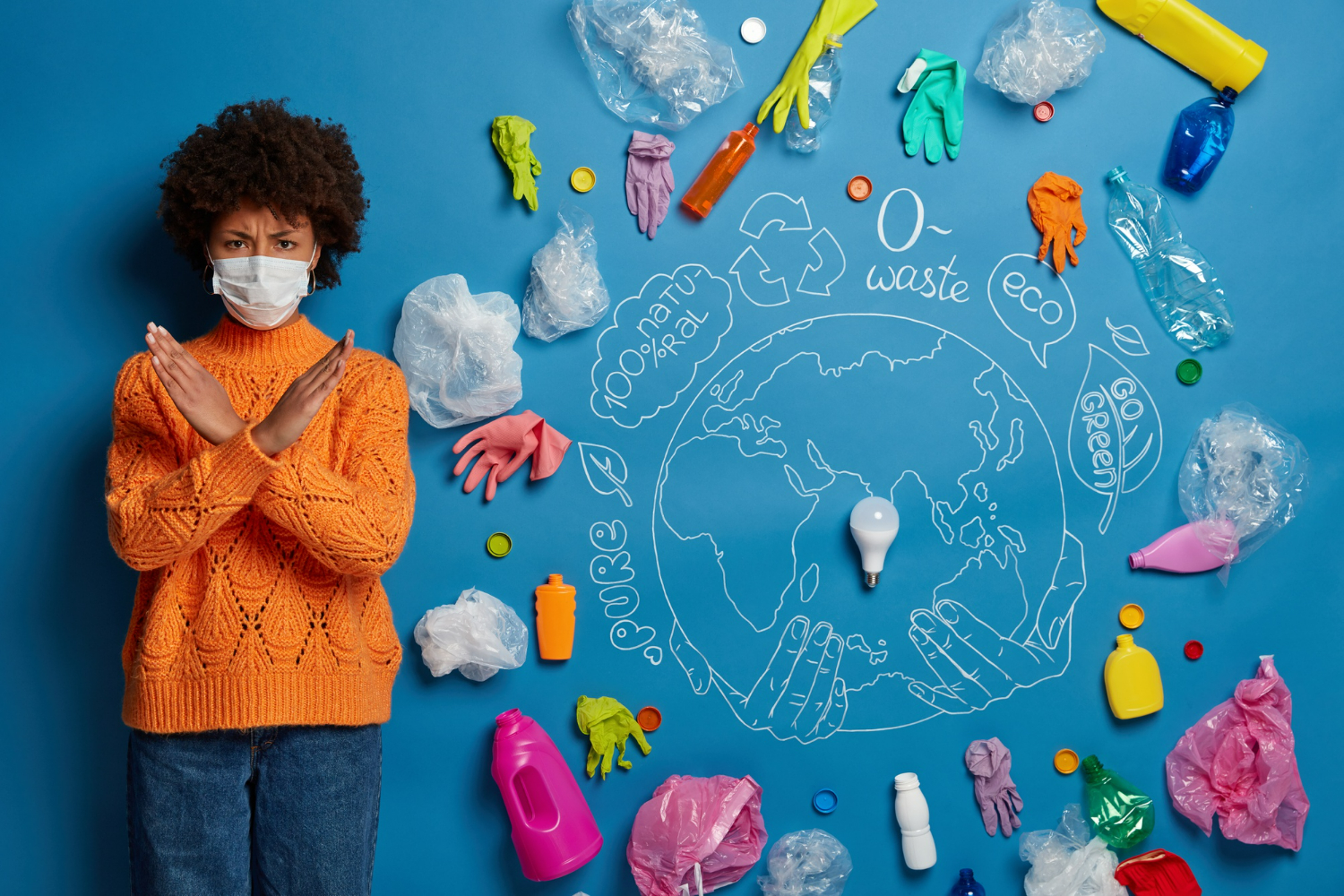
Plastic production, use and environmental pollution caused by it, has increased steadily around the globe. Apart of benefits, the complexity and diversity of plastic materials makes it difficult to assess health and ecosystem impacts. There is abundant scientific evidence that plastics at every point of their life cycle contribute to global health concerns.
Clear communication with consumers, which may also lead to behaviour change, is a key component when finding solutions. Many countries have introduced specific legislation and regulations regarding the usage of plastics, aiming at prevention, controlling the pollution by reducing or eliminating it wherever possible. The ban towards single use plastic is one of the immediate measures to heal the environment and protect from plastic pollution. Businesses are re-design products aiming to fit to circular economy and production loops. But a synchronised effort is required to achieve a behavioural change in the community.
Consumers are aware on the environmental and health impacts. Individual actions at family and community levels are frequent and calling for policy change on preventing plastic pollution. The public discourse supports the action but considers is insufficient to achieve tangible results. It should be accompanied with structural changes for re-modelling of production cycles, providing the consumer with new environmental-friendly alternatives. Producers and consumers should be encouraged by policies and incentives to minimise the packaging materials, which should be recovered by being collected separately and recycled.
YOUR CHALLENGE IS:
You are citizen in the capital of one economy of Western Balkans. The government has approved a new legislation on banning the single use plastic, for protection the environment. The legal incentive is based on the impact of plastic on rivers and seas, mainly caused by poor management of urban waste and throwing plastic bottles, containers and bags in open spaces, along riverbanks, etc. Yet, plastic containers for food and hygiene products are not part of this ban, justified by the necessity to comply with food and health safety.
WHAT IS THE PROBLEM ABOUT?

Some EU governments approved the new legislation on the ban of SUPs (Single Use Plastics). On June 2022, the Albanian government banned the plastic bags under 70 micron of the thickness, aiming at increasing the number of times each plastic bag is used, as well as contribute to recycling.
In addition, the thicker plastic bags are not distributed for free, but the customer has to pay from 0.05-0.1 EUR/bag. Some retailers and chain distributors replaced them with paper bags.
As a result of this action, the government claims there is significant reduction in the quality and volume of plastic bags placed in the market.
Direct impacts are mixed.
Negative impacts on the economy:
In 2019, there were 34 companies which produced plastic bags. It is estimated that the plastic industry has approx. 200 million EUR of investment and 30 thousand individuals employed directly or indirectly. With the new legal act, out of them 25 companies produce single use plastic bags. The production fall with 30%, followed by the laying out staff and employees. In addition, consumers are forced to pay for the plastic bags. For 30% of families which live with the minimal income, it will increase the burden on family expenditures. But on the other hand, it might revive the tradition of carrying reusable textile bags.
Positive impacts on the environment and health:
Plastic waste accounts for about 20-25% of the solid waste. The observation of these some rivers has shown that plastic in general and plastic bags in particular, constitute the main waste that is deposited on the Adriatic coast through river runoff. The results of the observation on an area of 100 m², in the Buna delta, showed that out of a total of about 46 kg of waste that was deposited, about 42.3 kg were plastic / polystyrene waste (mainly plastic carrier bags). For the same plot area, the quality is double in Ishmi river. Simple calculations come up with a volume of 26,282 tons less plastic waste/year.
Several environmental organizations and institutions organised campaigns along the streets of Tirana and main cities such as Shkodra, Durres, etc. for raising awareness on no-use of plastic bags, by distributing textile bags. During 2022, a national wide campaign “Me and you for the environment”, implemented by the Ministry of Tourism and Environment aimed at increasing the public awareness and change the behaviour.
Dilemma:
The waste resulting from the use of bags is up to 5% of the total plastic waste in developed countries, which have a higher consumption. In countries like Albania, the use of plastic bags does not even reach 3%. Part of it includes black garbage bags, bags, for which there is no question of banning the production anywhere in the world. Shopping bags (daily shopping, do not account for more than 1-2% of bag waste. Looking at the problem from this point of view, even if bags are banned 100%, the effect of reducing plastic will be only 2%, which does not solve or address the problem of pollution.
Even after the awareness campaign, there is plenty of plastic bags distributed (even for free by small shops and green markets). Some people say that they are just replaced with thicker plastic bags!
What is the argument for replacing the plastic containers with some environmental-friendly alternatives?
If you are aware of the negative impacts of plastic and you are willing to contribute for the reduction of plastic pollution, what would be the best action to start with in your community?
Choose alternatives that could solve the problem. You will collect one point for each correct alternative chosen. Please calculate your score. Total score is 10 points.



Correct answer is (1) Enforce the control in the production of plastic bags, which should comply for the composition and thickness, as this action prevents the production of plastic bags and further placement in the market. Fines would not work as they punish few individuals, and it is effective tool for changing the behaviour. For businesses the fine has to be proportionate to the damage, therefore it might be rather small value, so they not feel the impact.






All alternatives are correct. The advocacy campaign should target the policy level (alternatives 2, 3, 4) and the implementation and concrete actions (alternatives 1, 2);
- Advocate for separate collection of waste in the territory and support recycling.
- Advocate for financial incentives of businesses (producer) in using environmental-friendly packaging for less plastic material distributed in the market.
- Advocate for the implementation of Polluter-Pay-Principle (PPP) and Extended-Producer- Responsibility (EPR).
- Advocate for the ban of all SUPs, not only Single Use Plastic Bags.



1. By subsidising the costs of businesses and shops for distributing environmental-friendly products/packaging materials?



The correct answer is alternative 3. By informing and educating people on the benefits of replacing single use plastic and bear the cost of the action by paying a fee for each purchase of plastic bag. Informed and aware citizens understand the real costs of using plastic. Other alternatives which involved subsidies although might shift some weight for shoulders of the population, it will be paid out of collected other taxes. In addition, they to not contribute in changing behaviour. Same applied for introducing new tax, which is applied to every individual or family, without acknowledging the individual effort for reducing plastic pollution through using less or none of plastic bags or plastic packaging.



1. Use media products such as video and talks on TV channels?






If you collected more than 8 points for correct alternatives: You possess full understanding of the environmental impacts from plastic pollution and you are knowledgeable on the way to deliver the message to actors and community. You understand the limitations and effectiveness of addressing the problem partially or only by few actors.
If you collected from 5 to 7 points for correct alternatives: You might have dilemma in the environmental impacts of the plastic pollution or way how to address it effectively. Furthermore, you might either understand the problem partially, or are not involving all actors in the actions needed to solve the problem at the community level.
If you collected less than 4 points for the correct answers: You may have to look at the facts and data on the scale of the problem, its impacts on the environment and health of people. Furthermore, you might need to explore more on the involved actors (mainly the responsibility of producers, institutions, and individuals. You might need to consider the different tools and channels of communication with different actors through advocacy campaigns, information, and education tools.






Correct answer is (1) Enforce the control in the production of plastic bags, which should comply for the composition and thickness, as this action prevents the production of plastic bags and further placement in the market. Fines would not work as they punish few individuals, and it is effective tool for changing the behaviour. For businesses the fine has to be proportionate to the damage, therefore it might be rather small value, so they not feel the impact.


The correct answer is alternative 3. By informing and educating people on the benefits of replacing single use plastic and bear the cost of the action by paying a fee for each purchase of plastic bag. Informed and aware citizens understand the real costs of using plastic. Other alternatives which involved subsidies although might shift some weight for shoulders of the population, it will be paid out of collected other taxes. In addition, they to not contribute in changing behaviour. Same applied for introducing new tax, which is applied to every individual or family, without acknowledging the individual effort for reducing plastic pollution through using less or none of plastic bags or plastic packaging.


Therefore, effective stakeholder engagement requires an open and transparent two-way communication process, where stakeholders can participate and contribute to the decision-making process. This approach can help to build trust, foster collaboration, and create a sense of shared ownership and accountability, leading to better outcomes for all stakeholders involved.
Continue to Construction phase

Replay The Game

Continue to Operation and monitoring phase





